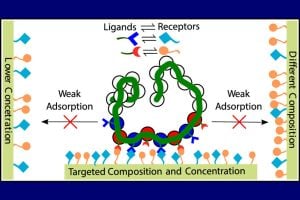
Chemotherapy can be lifesaving for cancer patients but often comes with side effects such as hair loss, nausea, and extreme fatigue. These occur because the drugs used cannot distinguish between healthy and cancerous cells, instead targeting all rapidly dividing cells— cancerous or healthy—in the body.
A Johns Hopkins materials scientist led a team that has innovated a way to engineer chemotherapy to target only cancerous cells, leaving healthy ones alone and potentially reducing or eliminating unpleasant side effects of treatment.
Using computational simulations, Tine Curk, an assistant professor of materials science and engineering at the Whiting School of Engineering, has demonstrated that copolymers—long strands of molecules—can be designed to deliver cancer-fighting drugs solely to diseased cells, sparing the healthy ones. “Designing Multivalent Copolymers for Selective Targeting of Multicomponent Surfaces,” is published in Macromolecules.
“It’s not easy to target cancer cells, because they are very similar to our healthy ones,” says Curk. “So, how do we get drugs to the right cells? One approach is to pinpoint the receptors that are more common in cancer cells. Copolymers have different molecules, called ligands, that will only stick to the surface of cells with a certain receptor pattern.”
Curk wondered if these ligands, or “keys” on copolymers would stick to certain receptors, or “locks” on cells, not just because of the receptor patterns, but also due to the specific composition of both the ligands and the receptors.
To find out, Curk used the Monte Carlo method, a well-known computational technique that derives its name from casino gambling.
“It takes random samples with random numbers to simulate a polymer above the cell,” says Curk. “Through these random placements, it finds how strongly the polymer will stick to different cells with varied receptor compositions.”
Curk discovered that copolymers can strongly adhere to cells with a specific composition profile of receptors. This means it is possible to identify which cells are cancerous and focus drug delivery on those abnormal cells, like locks that specific keys (such as drug molecules) can fit into. The team also found that if the ligands are repeated in a pattern, the copolymer becomes very good at targeting cells with certain receptors.
“Instead of having to experiment a million times with different combinations, computational materials science allows us to predict what will work with accuracy and try a few experiments in a lab rather than many,” says Curk. “We’re saving scientists time, effort, and money to bring this to life.”